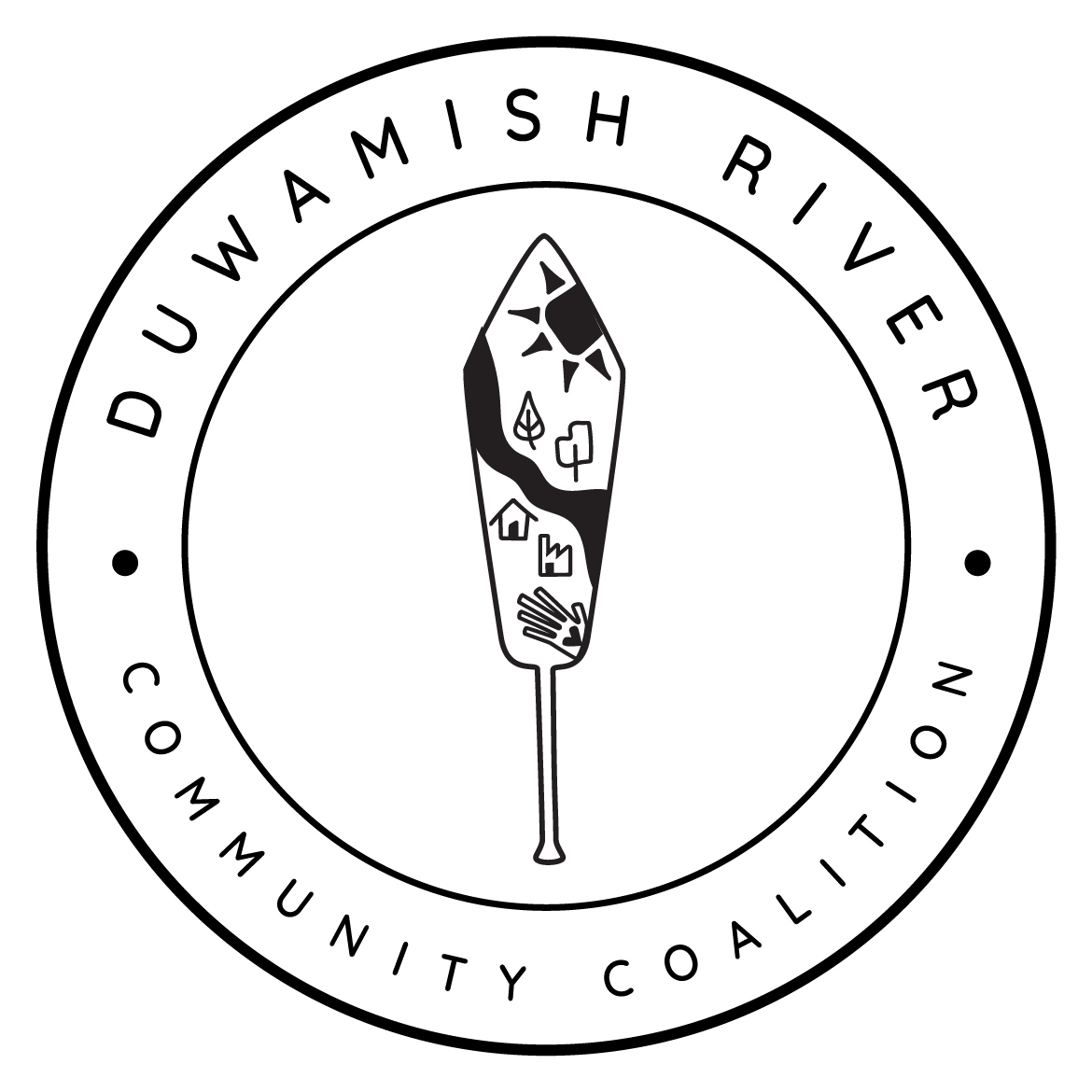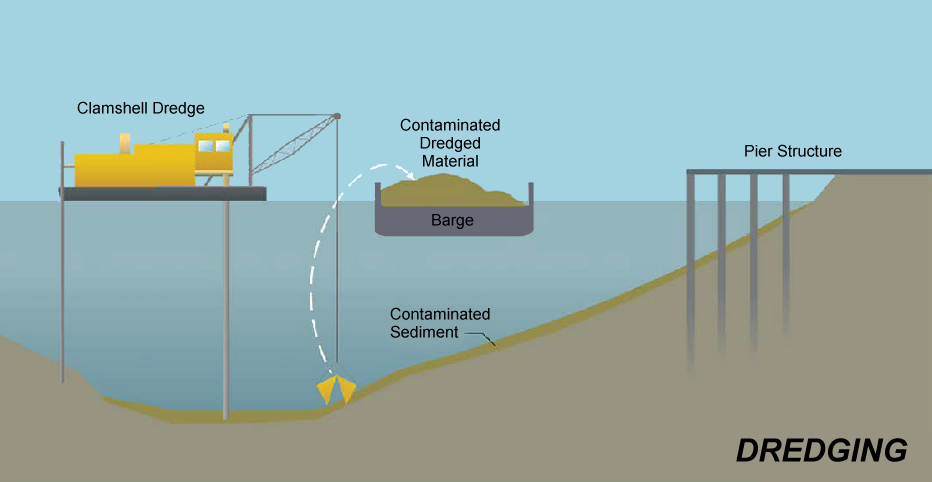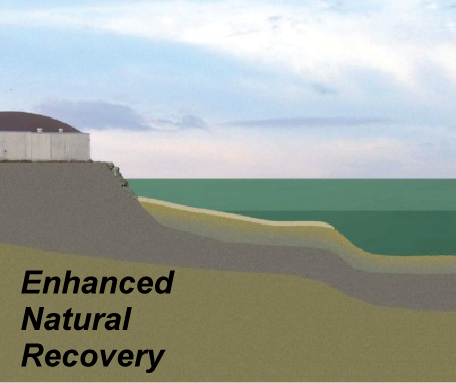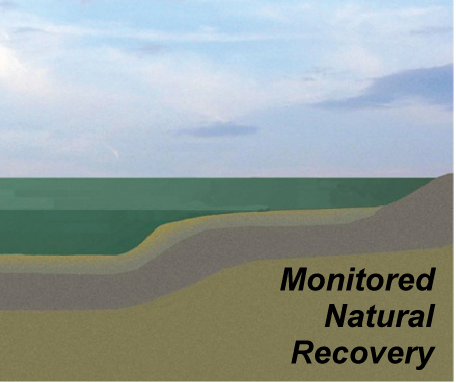In 2013, EPA released a Proposed Cleanup Plan received over 2,300 public comments. In order to issue the Final Cleanup Plan, EPA took into consideration these public comments, the level of toxicity in the mud, and the continued use of the river. In December 2014, EPA released its Final Cleanup Plan (called a “Record of Decision” or ROD). The ROD dictates the timeline and level of cleanup required, including where and how much toxic sediment needs to be removed, capped, or treated with other alternatives. The ROD focuses on acreage outside of the Early Action Areas mentioned above. It includes a mix of technologies to reduce toxic pollution levels in the mud (sediments) of the river, where fish and people are exposed. The ROD states that the remediation will include:
105 acres of Dredging: Dredging permanently removes bottom river mud using machines. The EPA recommends this remedy for the areas with the highest levels of toxic chemicals or where bottom river mud cannot be covered with a cap or natural river deposits (known as sedimentation).
24 acres to be Capped: Caps are engineered layers of sand designed to trap toxic mud beneath.
48 acres of Enhanced Natural Recovery: Areas with moderate levels of toxic pollution will be “kick-started” into natural recovery by treating with a 6 to 9-inch layer of sand.
35 acres of Monitored Natural Recovery: The rest of the area will receive no treatment and will be monitored to see if sedimentation covers the remaining pollution over time.
The Record of Decision describes the “how”, “how much”, and “when” of the cleanup of the Duwamish River. The final cleanup is expected to be complete in 2037. Here is a look at some of the steps in the cleanup process:
Allocation
Cleanup costs were divided among Potentially Responsible Parties (PRPs). Factors taken into account during allocation included the amount of waste present, the toxicity of the waste, and the degree of involvement of the party in generation or transportation of the waste.
Gathering Data About the River
The Remedial Investigation (RI) report involved the evaluation of the Superfund site, the nature of its contamination, potential risks to human and environmental health, and cost and effectiveness of potential treatment methods. The Remedial Investigation for the Duwamish River Superfund cleanup was paid for by the Lower Duwamish Waterway Group (LDWG) and includes results of river sampling, maps of chemicals found in the river bottom, information on risks to the environment and human health, and identification of ongoing sources of pollution.
A survey of the sediment at the bottom of the Duwamish River was conducted. Researchers found chemicals present that are harmful to human and animal health.
Quality of the river’s surface water was also tested. Researchers took normal samples of the river water, and also took samples after Combined Sewer Overflow events. The samples taken after CSO events had higher concentrations of fecal coliform that the normal samples.
Researchers tested the tissue of fish like salmon and English sole, and of shellfish like Dungeness crab and mussels for contaminants. It is now known that resident fish and shellfish from the Duwamish River are not safe to eat, and that even salmon passing through the river must be eaten in moderation. Please see the Washington State Department of Health’s Fish Consumption Advisory page (scroll down to Duwamish River section).
Please see the RI here to read more about tests on the Duwamish River.
Early Action Areas were selected based on the high risks to people or wildlife in and around the river. These areas were identified along the Duwamish River in 2003, which together contain approximately 50% of the estimated PCB pollutant load in the river. After identification, these sites were designated to be monitored and cleaned up. Duwamish River Early Action Areas include Slip 4, Duwamish/Diagonal, Terminal 117, Boeing Plant 2 (all of which have been cleaned) and Jorgensen Forge (which is being cleaned).
Baseline Testing
Baseline Testing will identify the types and levels of toxic pollutants present in the river before cleanup. It will expand on testing from the Remedial Investigation, establishing the post-EAA baseline conditions of environmental media such as sediment, water, and fish tissue. The Baseline Testing process will evaluate the effectiveness of recovery methods used since the Early Action cleanups and will also be compared with data that is gathered after the Superfund cleanup is complete
Technologies
Technologies such as the use of Enhanced Natural Recovery (ENR) and Activated Carbon were evaluated as potential cleanup methods. EPA’s final cleanup plan, the “Record of Decision”, states that ENR will be used in 48 acres of the total 177 acreage of planned cleanup area.
Understanding the Users and Uses of the RiverIt is important to understand that the Duwamish River has a diversity of users and uses that must be accounted for during the cleanup process to ensure all are benefited by the cleanup. EPA is conducting a “Waterway Users” survey this year to better understand how people are using the Duwamish River.
Fishers – Subsistence fishers use fish from the Duwamish River as a food source. In 2014, EPA started a Fishers Study to determine what, where, and why they fish. The Fishers Study Report was issued in December 2016. It was not limited to subsistence fishing only but anyone who was fishing and whether they were targeting fish that Washington Department of Health’s advisory recommends avoiding for consumption (resident fish and shellfish). In 2019, EPA finalized The Institutional Control Implementation and Assurance Plan (ICIAP) for promoting safe fish consumption behaviors within the LDW Superfund Site, and the ICIAP program included development of a website ( learn more HERE) for promoting safe fish consumption.
Industrial – The Duwamish River has historically been used by industry such as cement, asphalt, and concrete factories, metalworks, and shipping. Understanding the history of industrial use can help determine the source of pollutants.
Boaters – Recreational, industrial, and Tribal boaters have a presence on the Duwamish River.
Source Control Sufficiency
In order to have a lasting and effective cleanup, it is necessary for sources of pollution to be controlled sufficiently so they do not recontaminate the river during or after the cleanup process. See the Department of Ecology’s LDW Source Control page and Source Control Strategy.
According to the Department of Ecology’s Source Control Strategy, factors such as the number of contaminated sites, the potential existence of contaminated sites yet to be discovered, and the proximity of the sediment cleanup area to stormwater outfalls will be considered when determining source control sufficiency.
The Department of Ecology and EPA will be the final determinants of the levels of source control sufficiency. Part of DRCC/TAG’s role in the cleanup is making sure the community will be involved in determining the level of thoroughness of source control efforts. We will be commenting on source control sufficiency reports and providing them to the community for evaluation.
Remedial Design
The remedial design stage determines what construction will look like, who will be working on the site, and how cleanup technologies such as dredging, capping, enhanced natural recovery, and monitored natural recovery will be used. During this stage, potentially responsible parties, EPA, DRCC/TAG, community members, and others involved in the cleanup effort are planning to convene a roundtable for discussion. This way, the parties involved with creation of the plan can maintain communication with each other and community members will have the opportunity to play an active role in the remedial design stage.
EPA will continue to involve Duwamish River communities in the Superfund Job Training Initiative (SuperJTI) program. The program gives community members with skills and certifications to work on the Duwamish River Superfund site and make a difference locally. Contractors are a part of this program, and may provide employment opportunities for graduated trainees. Learn more here.
Active Cleanup
After the Remedial Design plans are made, construction and cleanup starts.
Monitoring
For 100 years after the conclusion of the active cleanup, the site may be monitored to ensure cleanup efforts were effective in the long-term.
Please see the EPA’s page about the general Superfund Cleanup Process.




